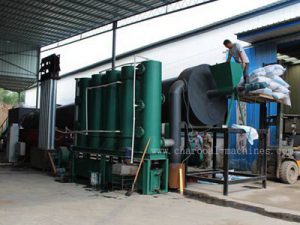Sürekli karbonizasyon fırını, hindistancevizi kabuğu karbonize edildiğinde, önce ezilmesi ve ne kadar ezileceği belirlenmelidir. Bu, müşterinin ihtiyaçlarına göre belirlenebilir. Sonraki adım kurutmadır. Kurutma da çok önemlidir. Genel olarak karbonize edilmiş ham madde, kurutulmamışsa karbonizasyon etkisi iyi olmaz; hindistancevizi kabuğunun kuruma derecesi yaklaşık - su olmalıdır, çok kuru olmamalıdır. Kurutma işleminden sonra karbonizasyon yapılır. Bu da çok önemlidir. Karbonizasyon iyi bir şekilde yönetilmezse, atılabilir, kül haline gelebilir veya kömürleşmeyebilir. Bu noktada karbonizasyon fırınının kullanımı çok önemlidir. Nasıl çalıştırılır? Dikkat edilmesi gereken birkaç nokta vardır.
1 Besleme makinesinin besleme işlemi, karbonizasyon makinesinin malzeme girişine göre gerçekleştirilmelidir. Düşme durumu başladığında besleme makinesi kapatılmalı ve karbonize edilmiş malzeme eklenmelidir. Alt besleme portundaki malzeme de çok birikmemelidir. Karbonizasyon tüpündeki malzemenin yaklaşık 2/3 oranında tutulması önerilir.
2 Karbonizasyon makinesinin hızı, karbon etkisine göre ayarlanmalı ve mil hızı uygun şekilde ayarlanmalıdır; karbon verimini sağlamak için mil hızı ayarlanabilir.
3 Dönme milinin her iki ucundaki mil yatağında duman sızıntısı olduğunda, vardiyadan sonra sızdırmazlık flanş somunu zamanında sıkılmalı ve gerektiğinde sızdırmazlık malzemesinin asbest paketleme şeridi değiştirilmelidir.


Nasıl çalıştırılacağını bildikten sonra, bir sonraki adım sıcaklık kontrolüdür; brülörün brülörü püskürtülür, karbonizasyon tüpü ısıtılır, termokupl fırın gövdesine uzatılır ve fırının içindeki alan, kontrol kabininin panelindeki sıcaklık kontrol cihazında kablo aracılığıyla görüntülenir. sıcaklık. (Karbonizasyon tüpünün içindeki gerçek sıcaklık, fırındaki ölçülen sıcaklıktan 200~300° daha yüksek olacaktır.) Çevre dostu karbonizasyon ekipmanı, fırında 15-20 dakika ısıtılır. Sıcaklık 550-600 dereceye ulaştığında, yükleme makinesinin başlatma düğmesine basılır; vida makinesindeki vida döner ve besleme makinesi beslemeye başlar. Karbonize edilmiş kabuk malzemesi, vida makinesinin spiralinde dönecektir. Boru gövdesi, malzemeyi karbonizasyon makinesi üzerindeki besleme portuna çıkarır.
Hindistan cevizi kabuğu malzemesi karbonizasyon makinesinin girişine doldurulduğunda, karbonizasyon ocağının başlatma düğmesine basın, elektromanyetik regülatördeki kırmızı anahtarı ON konumuna getirin ve hız kontrol düğmesini yavaşça çevirerek regülatörün sapma göstergesini ayarlayın. Bu, yaklaşık 500-600 devir/dakika (hindistan cevizi kabuğu için uygun) olduğunu gösterir. Karbonizasyon makinesinin vida mekanizması, malzemeyi ileri iterek, karıştırarak ve hareket ettirerek, üst ve alt kısımlardaki birinci ve ikinci karbonizasyon tüplerinde ön kurutma işlemi gerçekleştirir. Tortudaki su, egzoz borusu aracılığıyla dışarı atılır. Bacadan havaya atılır ve malzeme boruda bulunur. Bir veya iki boru kuruduğunda, üçüncü boruya geçildiğinde su birikmiş ve temizlenmiştir. Düşük sıcaklık karbonizasyon aşamasında, sürekli ilerleme, hareket ve karıştırma sonrasında, dördüncü tüpe girdiğinde, malzeme döndürülür, karıştırılır, itilir ve yüksek sıcaklık tüp gövdesinde bir mesafe boyunca hareket ettirilir ve alt sıcaklıktan yüksek sıcaklığa karbon tamamlanır. Karbon dönüşüm süreci sırasında, üretilen yüksek sıcaklık karbonu nihayet karbonizasyon makinesinin boşaltma noktasından su ceketli soğutma ve boşaltma makinesinin girişine atılır ve boşaltma makinesi tüpündeki yüksek sıcaklık karbon tozu, boru gövdesini çevreleyen soğutma suyu ile soğutulur ve nihayet boşaltma makinesi boşaltma noktasından soğutulmuş toner ve kurum çıkar. Daha önce açıklandığı gibi, bu işlem tekrar tekrar sürekli olarak çalışarak hindistan cevizi kabuğu ürünlerinin karbonizasyon sürecini tamamlar.
